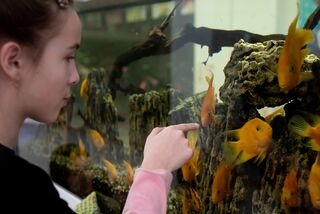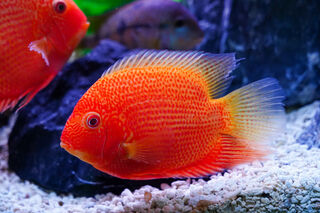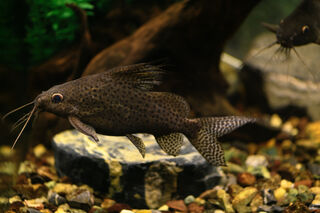Animal-assisted therapy has become more popular in recent years. It has been shown to improve the emotional well-being of patients, as well as people with behavioral issues. Animals have been reported to help facilitate a sense of calm and comfort and can even improve people’s feelings of self-worth and self-regulation. Often, animal therapy involves furry animals such as dogs, cats, or rabbits. Therapy with larger animals, such as horses or farm animals, also has been helpful for many patients (Maujean, 2015).

Watching fish also has been recognized as reducing stress and anxiety (Clements, 2019). Therefore, the waiting area in my office is decorated with two 225-gallon fish tanks, which serve as one of the first tools of therapy in my practice as a pediatrician who specializes in hypnosis and counseling. These tanks measure six feet across, two and a half feet tall, and two feet deep. One is for freshwater, and the other is for saltwater fish. (For those who do not know much about keeping fish, the saltwater tank is much more difficult to maintain.)
Friendly Fish
When I enter the waiting area, I often find my patients interacting with my fish. I have selected fish that tend to be very responsive to people, including freshwater red parrot fish and orange severum cichlids. The saltwater fish tend to be less interactive but often are very colorful, such as clownfish and tangs, which are the types of fish seen in the movie Finding Nemo. Thus, my saltwater fish are often recognized enthusiastically by the children who come to my practice.

On my practice website, I have a section devoted to “Our Fish,” in which patients and families can find biographies of some of the inhabitants of our tanks. Some children even know our fish by name before they even arrive at the office for the first time. I offer to let them name some of the fish as well. In this way, the children can feel more familiar and comfortable when they first arrive at the practice.
When I meet my patients in the waiting area, I often ask their opinions about the fish. These conversations serve as good ways to develop rapport, which is essential to effective therapy. Sometimes, I offer to have them feed the fish. Some kids respond enthusiastically, while others hold back, which allows me to assess their attitude before we enter the consultation room.
With younger children, I often ask if they have eaten any of my fish. When they deny doing so, I ask them to open their mouths so that I can inspect whether there are any fishtails hanging around. Usually, the kids go along happily with this request, which helps to establish a yes-set pattern. By saying ‘yes’ to my request for a mouth inspection, the children are then more apt to agree to later suggestions in the consultation room.
If older children need to be left by themselves in the waiting area, perhaps because I need to speak to their parents alone, I usually ask that they protect my fish from any predators, such as an elephant that might show up. Further, I beseech them not to go fishing or eat any of my fish. In this way, I jokingly imply that I trust them to take care of my important pets.
THE BASICS

Fish Metaphors
Sometimes, the fish serve as the basis for therapeutic metaphors. For example, Anthony, my upside-down catfish, only makes rare appearances in the daytime.
When he does come out, I suggest to the child, “Isn’t it interesting that sometimes we can find surprise guests in the tank?”
Later, in my consultation room, I might tell the same child, “You know, when you find knowledge within your subconscious, it’s similar to finding Anthony in the tank. He was always there, but you didn’t realize it.”
Or, I might ask a child, “Do you ever feel as if everyone is staring at you as if you were a fish in an aquarium?”
Sometimes, I ask children to come up with their own ideas about the fish that reflect how the children are coping and how their situation might improve. In this way, I am inviting the children to provide therapeutic advice. For example, I might ask a child dealing with social anxiety, “What do you think that fish ithinkswhen she swims all by herself? Do you have any ideas about how the fish could make some friends?”
Therapy Essential Reads
Or, I might ask a child dealing with sibling rivalry who is busy feeding the fish, “If you were in charge of the fish, what rules would you make about mealtime to help them get along better?”
Takeaway
Having a fish tank or other objects that capture children’s interest in the waiting area or consultation room (such as colorful paintings, fossils, or large minerals) can help facilitate therapy both through the promotion of stress reduction and encouragement of the children to engage in the therapeutic process.
Copyright Ran D. Anbar
To find a therapist near you, visit the Psychology Today Therapy Directory.
"fish" - Google News
October 29, 2022 at 09:09PM
https://ift.tt/FSjAbiY
The Role of a Fish Tank in Therapy - Psychology Today
"fish" - Google News
https://ift.tt/aO85gJp
https://ift.tt/bgNnCyK
Bagikan Berita Ini














0 Response to "The Role of a Fish Tank in Therapy - Psychology Today"
Post a Comment